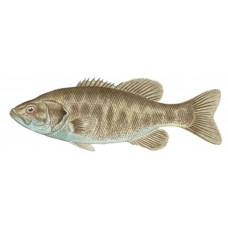Latin name
Micropterus notius
Other names
No information
Identification
Suwannee bass is similar in appearance to smallmouth bass and in markings to redeye bass, except that it is brown, and the cheeks, chest, and abdomen of large males are bright turquoise. It also has a large mouth, an upper jaw protruding below the eye, a denticle on the tongue, a spot at the base of the tail, and spots on the flanks. It can be identified by 59-64 lateral scales, 16 pectoral fin rays, 12-13 dorsal fin rays, and 10-11 anal fin rays.
Distribution
Suwannee bass is found in North America, usually in the Suwannee River in Florida and less frequently in the Ochlockonee River in northern Florida and Georgia.
Habitat
This species, a member of the family Centrarchidae, has the smallest habitat among all black bass. Suwannee bass are found in rocky riffles, channels, and pools, and are usually caught near rocky structures and along steep banks.
Size
The world record for all tackle is considered to be a 3-pound, 14-ounce fish caught in Florida in 1985.
Life history and Behavior
No information
Food and feeding habits
No information
Reproduction
No information
| Classification | |
| Phylum | Chordata |
| Class | Actinopterygii |
| Squad | Perciformes |
| Family | Centrarchidae |
| Genus | Micropterus |
| Species | M. notius |
| Features | |
| Conservation status | Near Threatened |
| Habitat | Pelagic |
| Life span, years | No information |
| Maximum body weight, kg | 1.8 |
| Maximum length, cm | 40 |
| Sailing speed, m/s | No information |
| Threat to people | Edible |
| Way of eating | Predator |


